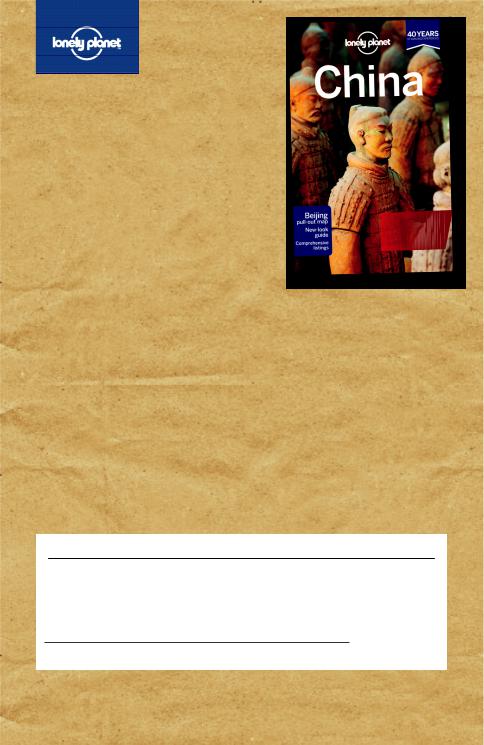
china-13-anhui
.pdf
China
Anhui
(Chapter)
Edition 13th Edition, May 2013
Pages 21
Page Range 375-395
Coverage includes: Ānhuī,Túnxī&around,HuīzhōuVillages,Huángshān,Jiǔhuá ShānandHéféi.
Useful Links:
Having trouble viewing your file? Head to Lonely Planet Troubleshooting. Need more assistance? Head to the Help and Support page.
Want to find more chapters? Head back to the Lonely Planet Shop.
Want to hear fellow travellers’tips and experiences?
Lonely Planet’s Thorntree Community is waiting for you!
© Lonely Planet Publications Pty Ltd. To make it easier for you to use, access to this chapter is not digitally restricted. In return, we think it’s fair to ask you to use it for personal, non-commercial purposes only. In other words, please don’t upload this chapter to a peer-to-peer site, mass email it to everyone you know, or resell it. See the terms and conditions on our site for a longer way of saying the above - ‘Do the right thing with our content.

©Lonely Planet Publications Pty Ltd
Ānhuī
POP 64.1 MILLION
Túnxī.............................. |
377 |
AroundTúnxī................. |
380 |
Huīzhōuvillages............ |
380 |
Huángshān.................... |
385 |
JiǔhuáShān.................. |
390 |
Héféi.............................. |
392 |
BestMountains
»»Huángshān (p385)
»»Jiǔhuá Shān (p390)
»»Qíyún Shān (p380)
BestVillages
»»Xīdì (p380)
»»Hóngcūn (p381)
»»Chéngkǎn (p383)
WhyGo?
Well-preserved villages and fantastical mountain scapes are the principal draw for visitors to Ānhuī ( ). The main attraction of this southern Huīzhōu region is unquestionably Huángshān, a jumble of sheer granite cliffs wrapped in cottony clouds that inspired an entire school of ink painting during the 17th and 18th centuries. But the oftenoverlooked peaks of nearby Jiǔhuá Shān, where Buddhists bless the souls of the recently departed, are much quieter, with a hallowed aura that offers a strong contrast to Huángshān’s stunning natural scenery.
At the foot of these ranges are strewn the ancient villages of Huīzhōu; their distinctive whitewashed walls and blacktiled roofs stand out against a verdant backdrop of green hills and terraced tea gardens. Ānhuī’s lush mountains and slower pace of life are the perfect antidote to the brashness of China’s larger cities.
WhentoGo
Túnxī
°C/°F Temp |
Rainfall inches/mm |
|
40/104 |
12/300 |
|
30/86 |
|
|
20/68 |
8/200 |
|
10/50 |
||
|
||
0/32 |
|
|
-10/14 |
4/100 |
|
-20/-4 |
||
|
-30/-22
-40/-40 |
|
|
0 |
J F |
M A M J |
J |
A S O N D |
Mar Summer |
Oct The terrain |
Dec The snow- |
days are best |
is awash with |
capped rooftops |
for climbing |
autumn colours – |
of Xīdì’s Hui |
ethereal |
Tǎchuān is par- |
houses make |
Huángshān. |
ticularly pretty. |
the bitter winter |
|
|
worthwhile. |

0 |
50 km |
0 |
30 miles |
 Fùyáng
Fùyáng
 Fùnán
Fùnán
Huai
River
Huáinán
Bèngbù |
Míngguƒng |
Hongze
Lake
Tianchang |
|
ChúzhŸu |
312 |
|
|
Quánjiƒo |
|
NÁNJ¹NG |
Yèjí |
HÉFÉI |
312 |
 Liù'ƒn
Liù'ƒn
Sh¥chéng
206
Caizi
Qiánshƒn Lake
M†'ƒnshƒn
 Cháohú
Cháohú
Chao
Lake
Lújiƒng
 (Cháng
(Cháng
Jiƒng)
 Tónglíng
Tónglíng
 Wúhú
Wúhú
Nan Lake
Nánlíng Xuƒnchéng
Guìchí |
Q¸ngyáng |
J¸ngxiàn |
|
Tàihú
Huángméi SùsŸng
Longgan
Lake
Ji©jiƒng |
Poyang
Lake
WuchangRiver
Lake
ngzi
Ya
„nqìng |
Ji©huáji‰ |
|
|
Tàipíng |
|
||
|
|
|
|
|
|||
|
Ji©huá Shƒn |
|
Reservoir |
|
|||
Shengjin |
(1342m) |
|
|
Tàipíng |
|
||
Lake |
Huángshƒn |
(Huángshƒn Q¥) |
|||||
|
(1873m) |
|
|
|
|||
|
Hóngc¥n |
|
Tƒngk¡u |
J¸xì |
|||
|
T†chuƒn |
|
|
||||
|
Guƒnlù |
Chéngk†n |
|||||
Nánpíng |
|||||||
|
|
|
Tángmó |
||||
Mùk‰ng Y¸xiàn |
|
X¸dì |
|||||
|
Yánsì |
Shèxiàn |
|||||
|
Qíyún Shƒn |
|
|
Túnx¸ Yúliáng |
|||
|
|
|
|
|
|||
|
|
|
|
|
205 |
|
|
|
|
|
|
|
|
Qiandao |
|
J¨ngdézhèn |
JI„NGX¹ |
|
|
|
|
Lake |
|
|
|
|
|
|
|||
ĀnhuīHighlights
1Climb and stay on the
iconic Chinese mountain,
Huángshān (p385)
2Explore the grottoes and
dilapidated temples atTaoist
Qíyún Shān (p380)
3Soak up the Ming-dynasty vibe alongTúnxī’s Old Street
(p377)
4Join the Buddhist pilgrims at fog-shrouded Jiǔhuá Shān
(p390)
5Don’t miss theWorld Heritage village of Hóngcūn
(p381)
6Eschew crowds and
enjoy authentic village life at
Chéngkǎnǎ (p383)
7Soar across heavy
plumes of feathery bamboo in Mùkēng…on a zipline (p382)
8Seek out the unmarked
Pig’s Heaven Inn (p382) in Xīdì for a fantastic meal
9Make a movie pilgrimage
to whereAng Lee andZhang Yimou shot films,in Guānlù
(p382)

History
TheprovincialbordersofĀnhuīweredefined by the Qing government, bringing together two disparate geographic regions and cultures: the arid, densely populated North China Plain and the mountainous terrain south of the Yangzi River (Cháng Jiāng), which wasn’t settled until the late Tang dynasty.
Traditionally impoverished, Ānhuī’s fortunes have begun to reverse. Some say the massive infrastructure improvements in the hitherto remote areas are partly due to president Hu Jintao, whose ancestral clan hails from Jìxī County. Hu comes from a long line of Huīzhōu merchants, who for centuries left home to do business or fill official posts elsewhere, but would never fail to complete their filial duty and send their profits back home (much of it by way of large homes and ceremonial structures).
These days, locals often leave the region to seek work and fortune elsewhere (no different from their ancestors). However, they are never ashamed to declare their origins. And rightly so.
Climate
Ānhuī has a warm-temperate climate, with heavyraininspringandsummerthatbrings plenty of flooding. Winters are damp and very cold. When travelling through Ānhuī at any time of year, bring raingear and a warm jacket for the mountain areas.
8 Getting There & Away
ThehistoricalandtouristsightsofĀnhuīare concentratedinthesoutharoundthetownof Túnxīandareeasilyaccessiblebybus,trainor planefromHángzhōu,ShànghǎiandNánjīng.
Túnxī
%0559 / POP 77,000
Ringed by low-lying hills, the old trading town of Túnxī (also called Huángshān Shì) is themainspringboardfortripstoHuángshān andthesurroundingHuīzhōuvillages.Ifyou stay in the old town, it’s an agreeable place withgoodtransportconnectionstotheYangzi River delta area. Compared with the region’scapital,Héféi,Túnxīmakesforabetter base from which to explore southern Ānhuī.
1Sights
Theoldestandmostinterestingpartoftown is in the southwest, along Old St (Lao Jie). The newer part of town is in the northeast, near the train station.
PRICE INDICATORS
The following price indicators are used in this chapter:
Sleeping
$less than ¥200
$$ |
¥200 to ¥550 |
$$$ |
more than ¥550 |
Eating
$less than ¥25
$$ |
¥26 to ¥60 |
$$$ |
more than ¥60 |
Old Street |
STREET |
( ; Lao Jie) Running a block in from the river, Old St is a souvenir street lined with wooden shops and restored Ming-style Huīzhōu buildings open till late. Duck into the side alleys for a glimpse at the local life and to find small eateries.
Wàncuìlóu Museum |
MUSEUM |
( ; Wàncuìlóu Bówùguǎn; 143 Lao |
|
Jie; admission ¥50; h8.30am-9.30pm) |
On Lao |
Jie, Wàncuìlóu Museum displays a private antiques collection, offering an introduction to Huīzhōu architecture and furniture over four floors.
TTours
Youth hostels offer a day-long village tour to Xīdì and Hóngcūn (¥210 including transport, admission fees and lunch) and a direct bus to Huángshān (¥18, one hour, 6.15am).
Huángshān Tourist »
Distribution Center BUSTOURS
( ; Lǚyóu Jísàn Zhōngxīn; %2558358;h7.30am-6pm) HuángshānTourist DistributionCenter–locatedinaconnecting buildingbesidethelong-distancebusstation– offer tours and discounted tickets.
4Sleeping
Ancient Town Youth Hostel HOSTEL$
( ; Xiǎozhèn Guójì Qīngnián Lǚshè; %252 2088; www.yhahs.com; 11 Sanma Lu;11 ; dm ¥40-45,d & tw ¥145-198; aiW)
Started by some former tour guides, this hos- telticksalltherightboxes,withawell-stocked bar, movie room, good lounging areas, friendly English-speaking staff, bike rental, organised tours and so on. Dorm beds are huge
377
SightsTúnxī Ānhuī

378
Túnxī |
|
|
|
|
|
|
|
|
|
|
|
e0 |
|
|
|
|
|
|
|
|
B |
|
|
|
|
|
# 0 |
|
A |
|
|
|
|
|
|
|
|
|
|
C |
|
|
|
|
|
|
|
|
|
Train Station‚X |
|||||
|
|
|
|
|
|
|
|
|
|
(1.8km) |
i |
||
|
|
|
|
|
|
|
|
|
|
' |
|||
|
|
|
|
|
|
|
|
|
|
|
|
|
n |
|
|
|
|
|
|
|
|
|
|
|
|
|
a |
|
|
|
|
|
|
|
|
|
|
|
|
|
n |
|
|
|
|
|
|
|
|
|
|
|
|
|
B |
|
Daizhen |
|
|
|
|
|
|
|
|
|
e |
||
1 |
|
|
|
|
|
|
|
|
|
i |
|||
Park |
|
|
|
|
|
|
|
|
|
l |
|||
|
66To Long-Distance |
|
|
|
|
|
u |
||||||
|
|
|
|
|
|
|
|||||||
|
Bus Station (1km) |
|
|
|
|
|
|
|
|
||||
|
‚ |
|
|
|
|
|
|
|
|
|
|
|
|
|
|
|
|
|
Wàncuìlóu |
|
|
|
|
|
|
Old |
|
|
|
|
|
|
Museum |
|
|
Lu |
|
|
Street |
||
|
|
|
|
|
|
|
|
n |
|
|
|
æ# |
|
|
5 |
|
|
|
ÿ#3 |
u |
Yan'a |
|
|
|
7 |
||
|
|
|
|
|
1 ÿ# |
|
|
||||||
|
ÿ# |
|
|
6 |
ú# |
â#L |
|
|
|
|
|
ú# ) |
|
|
|
|
a |
|
|
|
|
|
|||||
2 |
|
|
6m ò# |
|
|
(Ol Street |
|||||||
|
|
|
|
|
g |
Lao Jie |
|
d |
ÿ#4 |
|
|||
|
|
|
|
8 |
|
ÿ#n |
|
|
a |
|
|
||
|
|
|
|
|
o |
|
|
nm L |
|
|
|
||
|
|
|
# |
|
Z |
|
|
|
|
|
|||
|
|
|
|
2 h |
|
|
|
u |
|
|
|
||
|
Xī |
|
|
|
Bi |
|
|
|
Sa |
|
|
|
|
|
n' |
|
|
njiang Xilu |
|
|
|
|
|||||
|
|
ā |
n |
|
|
|
|
|
|
|
|
||
|
|
|
Ji |
|
|
|
|
|
|
|
|
|
|
|
|
|
|
āng |
|
|
|
|
|
|
|
|
|
|
A |
|
|
|
|
|
B |
|
|
|
|
|
C |
500 m
6Hui Peak D 0.25 miles
R
1
|
|
|
|
|
|
|
|
u |
|
|
|
|
|
|
|
|
il |
|
|
|
|
|
|
|
X |
|
|
|
|
|
|
|
n |
|
|
|
|
|
|
|
a |
|
|
|
|
|
|
|
h |
|
|
|
|
|
|
|
s |
|
|
|
|
|
|
|
g |
|
|
|
|
|
|
|
n |
|
|
|
|
|
|
|
a |
|
|
|
|
|
|
|
|
#ì H |
|
|
|
|
|
|
|
|
u |
|
|
|
|
|
|
|
|
To Public Security
Bureau (600m) 2
Chang‚gan
Zhonglu
D
|
|
Túnxī |
|
|
|
Ānhuī |
|
æTop Sights |
|
|
|
|
|
...............................................Old Street |
C2 |
|
|
|
|
Wàncuìlóu Museum |
B2 |
|
|
|
|
|
|
||
SleepingTúnxī |
|
ÿ Sleeping |
|
|
|
|
|
|
|||
|
1 |
Ancient Town Youth Hostel |
B2 |
|
|
|
|
|
|||
|
|
2 |
Harbour Inn & Bar................................. |
B2 |
|
|
|
3 |
Hui Boutique Hotel ............................... |
B2 |
|
|
|
4 |
Old Street Hostel .................................. |
C2 |
|
|
|
5 |
Túnxī Lodge ........................................... |
A2 |
|
|
|
úEating |
|
|
|
|
|
6 |
...................................Gāotāng Húndūn |
A2 |
|
|
|
7 |
Měishí Rénjiā ......................................... |
C2 |
|
|
|
ïTransport |
|
|
|
|
|
8 |
............Huángshān Air Travel Agency |
A2 |
|
|
|
|
|
|
|
and comfy, while the cheaper twin rooms are clean, though lacking in natural light. The moreexpensivedoublesarehotelquality.
Old Street Hostel |
HOSTEL$ |
( ; |
Lǎojiē Guójì Qīngnián |
Lǚshè; %254 0386; www.hiourhostel.com; 266 Lao Jie; 266 ; dm ¥35-45, tw ¥159-169, d/ tr/f¥139/199/219;aiW) With its convenient location anddecentrooms– thefour-person dorms come with proper mattresses and private bathrooms, while the private rooms sport wood-lattice decor and flat-screen TVs – this place clearly has an appeal that extends beyond the backpacking crowd. The 2nd floor houses a cafe overlooking Lao Jie with couches, pricey beer and a balcony. Staff speak English, though they tend to be efficient rather than warm.
oHui Boutique »
Hotel BOUTIQUE HOTEL$$$
( ; Huángshān Huīshèpǐn Jiǔdiàn;%2352003;www.huistylehotel.com;3Lihong Xiang; 3 ; r incl breakfast ¥5881080; aW) Tucked down an alley off Old St, this hotel, housed in a restored Qingdynasty building, is boutique chic meets traditional style. Dark rooms are deckedout with antique furnishings and modern toilets. There are 40% discounts online.
Harbour Inn & Bar HOTEL$$
( ; Yèbó Kèzhàn; %252 2179; 29 Zhongma Lu; 29 ; d & tw ¥200; aiW)
We’re not sure where to set sail from, but the rooms in this renovated traditional building in Túnxī’s old town are a notch above the typical midrange options. Get a twin that overlooks the street or splash out for the deluxe room for a chance to sleep in a traditional wooden Chinese canopy bed. A bar is located downstairs, for when you get bored looking at the floral wallpaper and matching bed sheets in the rooms.
TúnxīLodge HOTEL$$
( ; Túnxī Kèzhàn; %258 0388; 15 Lao Jie; 15 ; r incl breakfast ¥368-680; a)
At the western end of Lao Jie, this stylish hotel gets guests in the right mood with its Huīzhōu interior. The traditionally styled rooms have lovely wooden beds and clean, bright showers. There’s a decent attached restaurant serving Chinese and Western cuisine. Discounts knock a double down to ¥200.

5Eating & Drinking
There are cheap street eats and a variety of local restaurants in the area just east of the eastern end of Old St. There are restaurants galore on Old St and the streets abutting it. Zhongma Lu off Old St has a string of cute coffee shops and bars, all with free wi-fi, ¥12 to ¥20 coffees and ¥10 to ¥25 beers.
oMěishí Rénjiā |
CHINESE HUI$ |
( ; Lao Jie; dishes ¥7-56; hlunch & dinner) At the official entrance to Lao Jie, this bustling restaurant – spread over two floors and hung with traditional Chinese mǎdēng lanterns – seethes with satisfied customers. Peruse the counter for the range of dishes on display – húndūn (wontons; dumpling soup), jiǎozi (stuffed dumplings), bāozi (steamed buns stuffed with meat or vegeta- bles),noodles,claypotandmore–thenhave them cooked fresh to order. If you want to lingeroverameal,amoreexpensiveversion is located next door.
Gāotāng Húndūn |
WONTON$ |
( ; 1 HaidiXiang; húndūn ¥8-12; h10amlate) Duck down a little alley opposite 120 Lao Jie to enjoy a warming bowl of húndūn (wonton) made by a 12th-generation seller. The secret is in the superthin húndūn skins, meat minced from whole lean pork, and the tasty soup. No room on the skinny benches outside? Grab a seat in the owner’s living room: it’s set in an atmospheric Qing-era Hui home. Also sells dà húndūn (larger, vegie-filled dumplings).
8 Information
ThehostelshavePCsforinternet(¥4perhour).
Bank of China ( ; Zhōngguó Yínháng; cnr Xin’an Beilu & Huangshan Xilu; h8am- 5.30pm) Changes travellers cheques and major currencies; 24-hour ATM.
China Post ( ; Zhōngguó Yóuqū; 183 Lao Jie)
Public Security Bureau (PSB; ; Gōng’ānjú; %232 3093; 1st fl, 108 Changgan Zhonglu; h8am-noon & 2.30-5pm)
8 Getting There & Away
Air
DailyflightsfromHuángshānCityAirport(;HuángshānshìFēijīchǎng):
Běijīng ¥990, 2½ hours, one daily Guǎngzhōu ¥800, 1½ hours, two daily
Hong Kong ¥2250, 1¾ hours, three times a week Shànghǎi ¥500, one hour, one daily
YoucanbuyticketsattheHuángshān Air Travel Agency( ;Huángshān
HángkōngLǚyóuGōngsī;%2517373;1-1Bin- jiangXilu,h8am-5.30pm).
Bus
Thelong-distance bus station( ; kèyùnzǒngzhàn;QiyunDadao)isroughly2km westofthetrainstationontheoutskirtsoftown. Destinationsincludethefollowing:
Hángzhōu ¥89, three hours, hourly (6.50am to 5.50pm)
Jǐngdézhèn ¥61, 3½ hours, three daily (9.15am, noon and 2.10pm)
Nánjīng ¥120, 5½ hours, three daily (7.25am, 12.10pm and 4.20pm)
Shànghǎi ¥135, five hours, five daily (last bus 5pm)
Sūzhōu ¥132, six hours, two daily (6am and 6.50am)
Wùyuán ¥40, two hours, two daily (8.30am and 12.30pm)
Within Ānhuī, buses go to thesedestinations: Héféi ¥144, four hours, hourly
Jiǔhuá Shān ¥59, 3½ hours, one daily (1.30pm)
Shèxiàn ¥6, 45 minutes, frequent services
Yīxiàn ¥12.50, one hour, frequent services (6am to 5pm)
BusestoHuángshāngotothemainbaseat Tāngkǒu(¥13,onehour,frequent,6amto5pm) andontothenorthentrance,Tàipíng(¥20,two hours).TherearealsominibusestoTāngkǒu (¥15)frominfrontofthetrainstation.
Insidethebusstation(totherightasyou enter)istheseparateHuángshān Tourist Distribution Centre( ;Lǚyóu
JísànZhōngxīn;%2558358;h7.30am-6pm) withspecialtouristbusestopopulardestinations.Returnbusesoperatehourlyfrom8amto 4pm,withabreakfromnoonto1pm.Destinationsincludethefollowing:
Hóngcūn ¥14.50, 1½ hours Qíyún Shān ¥8.50, 40 minutes Xīdì ¥12.50, one hour
Train
Trainconnectionsareabysmal.Trainsfrom Běijīng(¥195to¥500,20hours,9.21am), Shànghǎi(¥110to¥265,13hours,8.45pmand 10.06pm)andNánjīng(¥70to¥159,sixto7½ hours,ninedaily)stopatTúnxī(generallycalled Huángshān).ThereisalsoservicetoJǐngdézhèn (¥25to¥115,threetofivehours,11daily).Forbetterconnectionstosoutherndestinations,firstgo toYīngtán(¥55to¥153,fivetoeighthours,nine daily)inJiāngxīandchangetrainsthere.
379
Drinking & EatingTúnxī Ānhuī

380
8 Getting Around
Taxisare¥5atflagfall,withthe5kmtaxiride totheairportcostingabout¥30.Competition amongpedicabdriversisfierce,sotheyarethe cheapestwayofgettingaround,costingapproximately¥4foratriptoOldStfromthetrain stationarea.Shortridesstartat¥2.Bus9(¥1) runsbetweenthebusstationandtrainstation; otherwise,ataxishouldcost¥7to¥10.
AroundTúnxī
|
QÍYÚNSHĀN |
|
|
A 40-minute bus trip west of Túnxī brings |
|
|
you to the lush mountain panoramas of |
|
|
Qíyún Shān (admission 1 Mar-30 Nov ¥75, 1 |
|
|
Dec-28 Feb ¥55; h8am-5pm Mon-Fri, 7.30am- |
|
|
5.30pm Sat & Sun). Long venerated by Tao- |
|
|
ists, the reddish sandstone rock provides |
|
|
a mountain home to the temples and the |
|
|
monks who tend to them, while mountain |
|
|
trails lead hikers through some stupendous |
|
Ānhuī |
scenery. |
|
fēng Bridge ( ; Dēngfēng Qiáo) – |
||
|
From the bus drop-off, cross the |
Dēng-» |
Around8 |
dwelling on the luxuriant river views – and |
|
stone steps to the ticket office. Or ask the |
||
|
turn right through the village at the foot of |
|
|
the mountain for a 75-minute clamber up |
|
Túnxī |
driver to drop you at the cable car ( ; |
|
Sǔodào; up ¥26, down ¥14) station ahead and do the circuit in reverse.
Beyond the ticket office, the Zhēnxiān Cave ( ; Zhēnxiān Dòngfǔ) houses a complex of Taoist shrines in grottoes and niches gouged from the sandstone cliffs. Seated within the smoky interior of the vast and dilapidated Xuán Tiān Tàisù Gōng (
)furtheronisaneffigyofZhengwu Dadi, a Taoist deity. A further temple hall, the Yùxū Gōng ( ), is erected beneath the huge brow of a 200m-long sandstone cliff, enclosed around effigies of Zhengwu Dadi and Laotzu.
There’s a completely charming village, Qíyún Village (Qíyún Cūn), seemingly plonked in the middle of the mountain range. Its whitewashed buildings are home to a variety of restaurants, souvenir stalls and friendly residents.
8 Getting There & Away
Tourist buses run directly to Qíyún Shān (¥8.50, 45 minutes) from the Túnxī longdistance bus station tourist centre, leaving hourly from 8am to 4pm. This bus can drop you at the Dēngfēng Bridge or the cable-car station. Otherwise, take any Yīxiàn-bound bus
from Túnxī and ask the driver to stop at Qíyún Shān. Returning to Túnxī, wait at the side of the road for buses coming from Yīxiàn, but note that the last bus from Yīxiàn to Túnxī departs at 5pm. The last tourist bus departs at 4pm.
HuīzhōuVillages
%0559
The home of highly successful merchants who dealt in lumber, tea and salt – in addition to running a string of lucrative pawnshops throughout the empire – Huīzhōu was a double-edged sword: the inhabitants were often quite wealthy, but they were also mostly absent. At age 13, many young men wereshuntedoutthedoorfortheremainder oftheirlivestodobusinesselsewhere,sometimes returning home only once per year. Rather than uproot their families and disrespect their ancestral clans, these merchants remained attached to the home towns they rarely saw, funnelling their profits into the construction of lavish residences and some of China’s largest ancestral halls.
Consequently, the villages scattered throughout southern Ānhuī (also known as Wǎnnán; ) and northern Jiāngxī are some of the country’s loveliest, augmented by the fact that they are often set in the lush surroundings of buckling earth and bamboo and pine forest, the silhouettes of stratified hills stacked away into the distance.
WESTERNVILLAGES(YĪXIÀN)
Yīxiàn is home to the two most picturesque communities in Ānhuī: Xīdì and Hóngcūn. Even with soaring ticket prices and when spilling over with crowds (most of the time), these are, hands down, the most impressive sights in the Huīzhōu area.
1Sights & Activities
Xīdì HISTORICVILLAGE
( ; admission ¥104) Dating to AD 1047, the village of Xīdì has for centuries been a stronghold of the Hu ( ) clan, descended from the eldest son of the last Tang emperor who fled here in the twilight years of the Tangdynasty.TypicaloftheelegantHuīzhōu style(seeboxedtext,p384),Xīdì’s124surviving buildings reflect the wealth and prestige of the prosperous merchants who settled here.
Xīdì’s Unesco World Heritage status means it enjoys a lucrative tourist economy. The village nevertheless remains a picturesque tableau of slender lanes, cream-

colouredwallstoppedwithhorse-headgables, roofscappedwithdarktiles,anddoorwaysornatelydecoratedwithcarvedlintels.
Wander around the maze of flagstone lanes, examining lintel carvings above doorways decorated with vases, urns, animals, flowers and ornamental motifs, and try to avoid tripping over hordes of high-school artists consigning scenes of stone bridges spanning small streams to canvas.
Xīdì’s magnificent three-tiered Mingdynasty decorative arch, the Húwénguāng Páifāng( ),attheentrancetothe village, is an ostentatious symbol of Xīdì’s former standing. Numerous other notable structures are open to inspection, including the Díjí Hall ( ; Díjí Táng) and the Zhuīmù Hall ( ; Zhuīmù Táng), both on Dalu Jie ( ). Jìng’ài Hall ( ; Jìng’ài Táng), is the town’s largest building andwasusedformeetings,weddingsand,of course, meting out punishment. Back in the day, women weren’t allowed in the hall; oh, how things have changed. Xīyuán ( ) is a small house known for its exquisite stone carvings on the windows. Unlike regular carvings,thesearecarvedonbothsides.The owner is said to have previously rejected offers of US$10,000 (each!) for them.
When you’re done with the village, pop out on paths leading out to nearby hills where there are suitable spots for your picture-postcard panoramas of the village (though a mobile-phone tower now blights the landscape). If you want to avoid the crowds, you’ll have to start early or hang out late: tour groups start roaming around at 7am and only trickle out at 5pm or so.
Hóngcūn |
HISTORICVILLAGE |
( ; admission ¥104) Dating to the southern Song dynasty, the delightful village and Unesco World Heritage site of Hóngcūn, 11km northeast of Yīxiàn, has at its heart the crescent-shaped Moon Pond ( ; Yuè Zhǎo)andisencapsulatedbySouthLake(; Nán Hú), West Stream ( ; Xī Xī) and Léigǎng Mountain ( ; Léigǎng Shān). Founding village elders of the Wang ( ) clan consulted a feng shui guru and the village was remodelled to resemble an ox, with its still-functioning waterway system representing the entrails. Wealth soon followed, though the descendants of the Wang clan now trade in tourism rather than goods.
Today, the village is a charming and unhurried portrait of bridges, lakeside views, narrowalleysandtraditionalhalls.Alleyway
channels flush water through the village from West Stream to Moon Pond and from there on to South Lake, while signs guide visitors on a tour of the principal buildings. Lost? Just follow the waterflow.
If the bridge at the entrance to the villagelooksfamiliar,it’sbecauseitfeaturedin the opening scene from Ang Lee’s Crouching Tiger, Hidden Dragon. The picturesque Moon Lake also features in the film. The Chéngzhì Hall ( ; Chéngzhì Táng; Shangshuizhen Lu; ) dates from 1855 and was built by a salt merchant. It has 28 rooms, adorned with fabulous woodcarvings, 2nd-floor balconies and light wells. Peepholes on top-floor railings are for girls to peek at boy visitors and the little alcove in the mahjong room was used to hide the concubine. The now-faded gold-brushed carvings are said to have required 100 taels of the expensive stuff and took over four years to be completed.
Other notable buildings include the Hall of the Peach Garden ( ; Táoyuán Jū), with its elaborate carved wood panels, and the South Lake Academy ( ; Nánhú Shūyuàn), which enjoys an enviable setting beside tranquil South Lake. Overlooking Moon Pond is a gathering of further halls, chief among which is the dignified Lèxù Hall ( ; Lèxù Táng), a hoary Ming antique from the first years of the 15th century. Turn up bamboo carvings, trinkets and a large selection of tea at the market west of Moon Pond. The busy square by Hóngjì Bridge ( ; Hóngjì Qiáo) on the West Stream is shaded by two ancient trees (the ‘horns’ of the ox), a red poplar and a gingko.
Admission to the village includes a guide with limited English-speaking skills – you’ll have to engage one at the main entrance in case you enter by the side gate.
Tǎchuānǎ HISTORICVILLAGE
( ; admission ¥20) Located 3km northwest of Hóngcūn is the tiny little village of Tǎchuānǎ. It’s set at the base of a valley and noted for its stunning autumn scenery. Each year, the leaves on old-growth trees in and around the village change colours for anywhere between 10 to 30 days. The entire valley comes ablaze in shades of orange, green and brown, much to the delight of photographers. On other days, the villagers eke out their living by planting rice and tea. From afar, the village looks like a pagoda as it’s built across the steps of foothills. New
381
Villages Huīzhōu8 Ānhuī

382
management was not providing guides or house visits when we called, but in case the service is reinstated, house 18 has some of the most exquisite wooden carvings in the region. Otherwise, you could look out for dilapidated house 25 where you’ll find empty antique furnishing and other bits and pieces strewn across a traditional Hui house.
|
Nánpíng |
HISTORICVILLAGE |
|
|
( ; admission ¥43) With a history of more |
||
|
than 1100 years, this intriguing and laby- |
||
|
rinthine village, 5km to the west of Yīxiàn |
||
|
town, is famed as the setting of Zhang Yi- |
||
|
mou’s 1989 tragedy Judou and, of course, |
||
|
scenes from Crouching Tiger, Hidden Drag- |
||
|
on. Numerous ancient ancestral halls, clan |
||
|
shrines and merchant residences survive |
||
|
within Nánpíng’s mazelike alleys, including |
||
|
the Chéngshì Zōngcí ( ) and the |
||
|
Yèshì Zōngcí ( ). The Lǎo Yáng |
||
|
Jiā Rǎnfáng ( ) residence that |
||
Ānhuī |
served as the principal household of dyer |
||
Gongli and her rapacious husband in Judou |
|||
|
|||
|
remains cluttered with props, and faded |
||
Huīzhōu8 |
stills from the film hang from the walls. |
||
Guānlù |
HISTORICVILLAGE |
||
|
Admission includes a guide with limited |
||
|
English-speaking skills. |
|
|
Villages |
( ; admission ¥35) Around 8km west of |
||
Yīxiàn and further along the road beyond |
|||
|
|||
|
Nánpíng, this small village’s drawcard sights |
||
|
are the fabulous households – Bādàjiā ( |
||
|
) – of eight rich brothers. Each Qing- |
||
|
dynasty residence shares similar elegant |
||
|
Huīzhōu features, with light wells, interior |
||
|
courtyards, halls, carved wood panels and |
||
|
small gardens. Each an independent entity, |
||
|
the households are interconnected by doors |
||
|
and linked together into a systemic whole. A |
||
|
distinctiveaspectoftheresidencesistheirel- |
||
|
egantlypaintedceilings,thepatternsandde- |
||
|
tails of which survive. The houses have now |
||
|
been subdivided among the descendants’ |
||
|
families, and many wings are in disrepair as |
||
|
many of the younger villagers have left for |
||
|
more modern abodes. Admission includes a |
||
|
guide with limited English-speaking skills. |
||
|
Mùkēng Zhúhǎi |
FOREST |
|
( ; admission ¥30) A hike through Mùkēng’s bamboo forest is an excellent way to escape the megaphones and roving packs of art students in the nearby towns. Remember Crouching Tiger, Hidden Dragon’s breathtaking bamboo-top fight scenes? Yep, they were filmed here. The two-hour circuit along a ridgeline leads past the top-
heavy plumes of feathery bamboo, trickling streams and hillside tea gardens, past a smallvillagewhereyoucangetafillingmeal and a clean room with bathroom for ¥60 to ¥120, and eventually to a small hamlet where you can break for a cup of chá (tea). Perhaps inspired by the movie, a zipline (¥40) has been built near the highest point inthetrail;it’sa40-secondziptothebottom from more than 75m above the ground! The forest is 5km northeast of Hóngcūn.
4Sleeping & Eating
Due to local regulations, it’s not possible to just turn up and find simple homestay-style accommodation ( ; zhù nóngjiā) in Xīdì and Hóngcūn. Each of the villages has ‘approved’ accommodation for foreigners, most listed below. You can visit local homes to sample some excellent cooking (meals are generally around ¥20, unless you have a chicken slaughtered, which will cost ¥50 to ¥100). Restaurants abound; in spring, succulent bamboo shoots ( ; zhúsǔn) figure prominently in many dishes.
XĪDÌ |
|
Pig’s Heaven Inn |
BOUTIQUE HOTEL$$$ |
( ; Zhūlán Jiǔbā; %515 4555; http://blog. sina.com.cn/zhulanjiuba; Renrang Li;;dinclbreakfast¥360,ste¥460-880;aW) This is a 400-year-old house in Xīdì that has been restored, with a study, two terraces and five distinctive rooms. Reservations are essential (the entrance is unmarked); gourmet sleuths can seek it out for a fantastic lunch (dishes from ¥20) in the courtyard. The owners have developedalarger,pricierpropertyinBìshān ( ), several kilometres away. This is a great place to just unwind for a day or three; grab one of their bicycles and explore the surrounding area. Transfers to both properties are available. Limited English.
Xīdì Travel Lodge HOTEL$$
( ; Xīdì Xíngguǎn; %515 6999; www.xi dilodge.com; ; d incl breakfast ¥368-488, ste ¥608-1288; ai) This can’t-miss-it property just behind the main gate to the Xīdì village, is a sprawling, multibuilding affair complete with comfortable rooms and its own restaurant and alfresco cafe. All rooms have modern showers, flat-screen TVs and faux antique furnishing, while some have balconies.Getaroomfacingthesmallteagarden. The restaurant serves local fare (dishes ¥18 to ¥108) and there’s cheap ¥10 beer at the cafe. Discounts of 30% available.

HÓNGCŪN
oLong Lane Inn BOUTIQUE HOTEL$$$
( ; Hóngcūn Yìpǐn Gēng Lóu; %554 2001;www.hcno-1.com; 1 ShangshuiQuan;1 ;rinclbreakfast¥380-1280;aW) Sitting in a quiet corner of Hóngcūn, this 10-room Taiwanese-run boutique hotel is a welcome additiontothevillage.Visitorshaveachoice of rooms: traditionally styled with rosewood Chinese four-posted beds (or splash out for the suite with a cute garden and sunken bath) or simple tatami rooms, each one comfortable and immaculate. In-house meals are great too. Iris, the owner, speaks good English and can help with travel plans and private-vehicle hire.
Hóngdá Tíngyuàn HOMESTAY$
( ; %554 1262; 5 Shangshui Zhen;5 ;r¥100) ThedrawofthisHóngcūn home is the verdant courtyard filled with potted daphne, heavenly bamboo and other flowering shrubs, all set around a small pool and pavilion. Its rooms are unadorned, but the peaceful location in the upper part of the village is ideal. You can stop by for lunch (dishes from ¥20), space permitting. No English spoken.
8 Getting There & Around
BUS TouristbusesrundirectlytoXīdì(¥12.50, onehour)andthentoHóngcūn(¥14.50,1½ hours)fromtheTúnxīlong-distancebussta- tion’stouristcentre,leavinghourlyfrom8amto 4pm,withabreakatnoon.Otherwise,catcha localbusfromthelong-distancebusstationto Yīxiàn(¥13,onehour,frequent,6amto5pm), thetransporthubforpublictransporttothe surroundingvillages.
FromYīxiàntherearegreenminibuses(¥2, half-hourly,7amto5pm)toXīdì(15minutes), Nánpíng(15minutes),Guānlù(20minutes)and Hóngcūn(20minutes).Youwillneedtoreturn toYīxiàntogetbetweenthedifferentvillages, withtheexceptionofNánpíngandGuānlù,which arebothinthesamedirection.FromYīxiàn,it’s possibletotravelontoTāngkǒu(¥15,onehour, fourdaily)andQīngyáng(¥38,2½hours,three daily).
BICYCLE Agreatwaytoexplorethesurroundingcountrysideisonbikes( ;chūzū zìxíngchē;per4hr¥5-15),foundonthemodern streetoppositeHóngcūn’sHóngjìBridge(;HóngjìQiáo).
TAXI TaxisandpedicabsgotoXīdì(¥10), Hóngcūn(¥15),Nánpíng(¥20)andGuānlù(¥25) fromYīxiàn.Bookingapedicabtotakeyouto allfourvillagesfromYīxiàncancostaslittleas ¥150fortheday,dependingonyourbargaining
skills.Aminivanforthedaywillcost¥300to ¥400.Mostaccommodationplacescanhelp withtransportbookings.FromHóngcūn,geta pedicabtoTǎchuān(¥10)andMùkēngZhúhǎi (¥15).You’llneedtonegotiateforthedriverto waitforyouasreturningpedicabsarerare.
NORTHERNVILLAGES
Rarely visited by individual travellers, the villages north of Túnxī can serve as a quieter antidote to the much-hyped and crowded towns to the west.
1Sights
Chéngkǎn HISTORICVILLAGE
( ;admission¥80;h8am-5pm) A real working community, Chéngkǎn presents a very different picture from its more affluent cousins in Shèxiàn – farmers walk through town with hoes slung over their shoulders, tea tradersdumpbasketsoffreshlypickedleaves straight out onto the street, quacking ducks run amok in streams and there’s the unmistakablesmellofpigmanureintheair:abona fide slice of life in rural China. Most visitors come to see southern China’s largest ancestral temple ( ; Luó Dōngshū Cí), a massive wooden complex several courtyards deepthattook71years(1539–1610)tobuild.It has a mixed bag of architectural styles: from Greco-RomancolumnstoPersianpatternson overhead beams. There are other venerable structures in town, such as the three-storey Yànyì Táng ( ), which is nearly 600 years old; however, many residences are in poor condition. Look out for a house where the owner still gives haircuts (¥2) on his 100-year-old-plus chair. The mirror is just as old. Another big appeal lies in the lush panoramasofthesurroundingĀnhuīcountryside.
Tángmó |
HISTORICVILLAGE |
( ; admission ¥80, incl electronic guide deposit ¥300; h8am-5pm) A narrow village that extends 1km along a central canal, Tángmó was originally established during the late Tang dynasty. A pathway follows the waterway from the entrance at the east gate (; dōng mén) into the village, leading past the large Tán’gàn Garden ( ; Tán’gàn Yuán),which was modelled after Hángzhōu’s West Lake. Here you’ll enter the village proper, passing canalside Qing residences along Shui Jie ( ) before coming to the covered Gāoyáng Bridge ( ; Gāoyáng Qiáo), built in 1733 and now home to a small teahouse. At the end of town is the Shàngyì Ancestor Hall( ; Shàngyì Táng), with 199peonyblossomscarvedintotheentrance
383
Villages Huīzhōu8 Ānhuī
